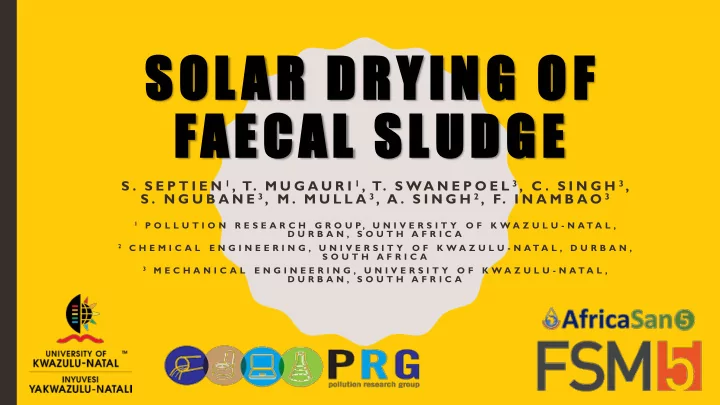

SOLAR DRYING OF FAECAL SLUDGE S . S E P T I E N 1 , T. M U G A U R I 1 , T. S WA N E P O E L 3 , C . S I N G H 3 , S . N G U B A N E 3 , M . M U L L A 3 , A . S I N G H 2 , F. I N A M B A O 3 1 P O L L U T I O N R E S E A R C H G R O U P, U N I V E R S I T Y O F K W A Z U L U - N A T A L , D U R B A N , S O U T H A F R I C A 2 C H E M I C A L E N G I N E E R I N G , U N I V E R S I T Y O F K W A Z U L U - N A T A L , D U R B A N , S O U T H A F R I C A 3 M E C H A N I C A L E N G I N E E R I N G , U N I V E R S I T Y O F K W A Z U L U - N A T A L , D U R B A N , S O U T H A F R I C A
SUMMARY I. Introduction II. Solar drying thermobalance III. Bench-scale solar drier IV.Future work
Transport cost Volume and decrease EXPENSIVE Faecal mass reduction sludge PROCESS! drying Pasteurization High CAPEX Agriculture and OPEX Biofuel Low moisture content + Organic content
SOLAR DRYING, AS A LOW-COST ALTERNATIVE OF CONVENTIONAL DRYING Source: https://recipes.howstuffworks.com/dehydrated-food1.htm Source: http://www.tirme.com/es/upload/67pdf_file12_07_31.pdf Source: http://www.huber.de/ Most ancient application of solar energy • • Main applications in food industry and crop conservation • Greenhouses for sewage sludge drying in developed countries Largest plant in Mallorca, Spain • (treatment 30,000 tonnes of sludge per year) Source: http://www.redco.com.tr Source: http://iufost.org/wp-content/uploads/05-Solar%20Drying%20Article%20+%20photo.pdf
SOLAR ENERGY IN THE WORLD AND AFRICA Developing countries facing lack of sanitation (among African countries) situated within the solar belt with the highest irradiances
DRYING BEDS VS SOLAR THERMAL SYSTEM Source: https://www.huber.de/products/sludge-treatment/sludge-drying/huber-solar-active-dryer-srt.html Source: https://www.huber.de/products/sludge-treatment/sludge-drying/huber-solar-active-dryer-srt.html MORE COST EFFECTIVE LOW COST SOLUTION BUT: • Lower drying times Long drying times • • Conditions controlled Possible rehydration • • Lower surface area Large surface area • Thermal efficient • Thermal inefficient • Higher temperatures • Proliferation of pests • Higher pasteurization Pasteurization inefficient • • Possibility of automatization • Intense labour
USE OF SOLAR THERMAL ENERGY IN FSM (CURRENTLY LOW) Source: https://www.colorado.edu/solchar/about/our-approach Source: Source: http://www.climateincorp.com/product- Source: https://www.breakingnews.ie/world/fake-poo-project- https://www.susana.org/_resources/documents/ catalog/sani-solar-sanitation/sani-solar-sanitation/ could-cut-illness-and-deaths-in-developing-countries-814850.html default/3-2106-22-1424426286.pdf
INVESTIGATIONS AT PRG - UKZN Generate data and knowledge about faecal sludge solar drying through experimental work at laboratory scale Increase awareness about faecal sludge solar drying Support the improvement of existing technologies Promote the development of innovations and new technologies
SUMMARY I. Introduction II. Solar drying thermobalance III. Bench-scale solar drier IV.Future work
EXPERIMENTAL SETUP 5 h/d Oct - Nov Sludge: thin layer (few g)
EFFECT OF WEATHER CONDITIONS Initial Moisture Content (M.C.) = 80% wet total (w.t.) Overcast conditions: lowest drying rate (~ 0.5 kg/h/m 2 ) M.C. = 50 % w.t. Sunny conditions: highest drying rate (~ 0.8 kg/h/m 2 ) M.C. = 30 % w.t.
Better performance of solar drying compared to open-air drying Highest difference in overcast conditions
OUTCOMES FROM THE INVESTIGATION After 5 hours of solar drying in the Surface area of a soccer pitch (4500 m 2 ) : spring in Durban: • Moisture reduction between 60 to 95% • Drying rate between 0.5 and 1.0 kg/h/m2 • Temperatures up to 40ºC (+20ºC than ambient temperature) Challenges: • Crust formation Source: https://www.mmstadium.com/news/rhinos/ • Variability weather conditions • 5 ton / h • 2.5 ton / year / m 2 (5-8 hours of operation )
SUMMARY I. Introduction II. Solar drying thermobalance III. Bench-scale solar drier IV.Future work
DEVELOPMENT OF A SOLAR DRIER Greenhouse Piping and (drying chamber) thermal insulation Ventilation Sample holder + stirring Solar collector (air Tilting heating) support Protection against (optimal solar radiation angle) Process Weather instrumentation station (temperature, air (irradiance) relative humidity)
TRIAL WITH SYNTHETIC SLUDGE (OCT0BER) DAY 1 DAY 2 DAY 3
SPECIFICATIONS OF SOLAR DRYER Parameter Value Mass of sludge 4.5 kg Operation time 9 h/d Surface area 0.34 m 2 Air temperature 50 - 80ºC Energy consumption 0.225 kWh/d (25 W fan) (80 kWh/y) 0.5 kg/h/m 2 Drying rate (1.5 ton/y/m 2 ) 0.150 kWh/kg Performance process (150 kWh/t) Conventional dryers: 800 – 1000 kWh/t
SUMMARY I. Introduction II. Solar drying thermobalance III. Bench-scale solar drier IV.Future work
FUTURE WORK Continuation of the current investigations with a Master project and intern, in order to generate further data and understanding Development of a solar drying technology at pilot-scale in order to provide cost effective solutions for faecal sludge treatment Source: Mathioudakis, V.L., Kapagiannidis, A.G., Athanasoulia, E., Paltzoglou, A.D., Melidis, P., Aivasidis, A., 2013. Sewage sludge solar drying: Experiences from the first pilot-scale application in Greece. Dry. Technol. 31, 519 – 526./
FUTURE WORK Engineering field testing of a solar dryer developed by Swansea University Source: https://www.tatasteelconstruction.com/en_GB/Products/Building-envelope/Walls/active-solar-air-heating/Colorcoat-Renew--SC%C2%AE Development of Centre of expertise on solar drying and faecal sludge drying
ACKNOWLEDGMENTS Water Research Commission EThekwini municipality for their funding for their support Technical staff from the Pollution Research Group, Chemical & Mechanical Engineering department (laboratory, workshop, administrative)
THANKS FOR YOUR LISTENING Reports and papers from this project available by request In research of partners and a motivated master student for the new project about the development of a solar drier Contacts details: Santiago Septien Stringel septiens@ukzn.ac.za +27738711375
Recommend
More recommend